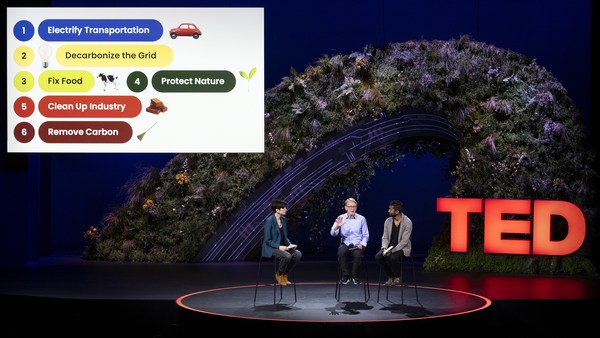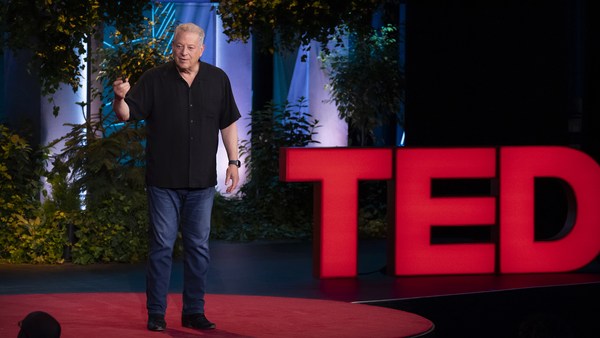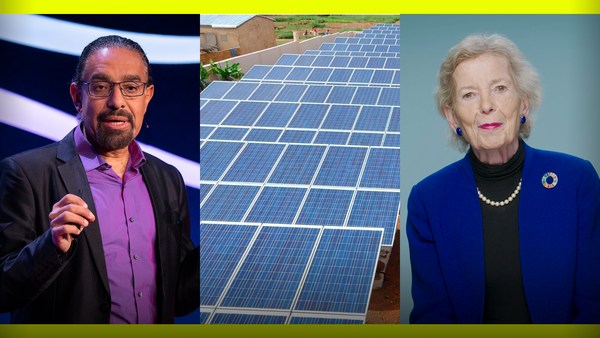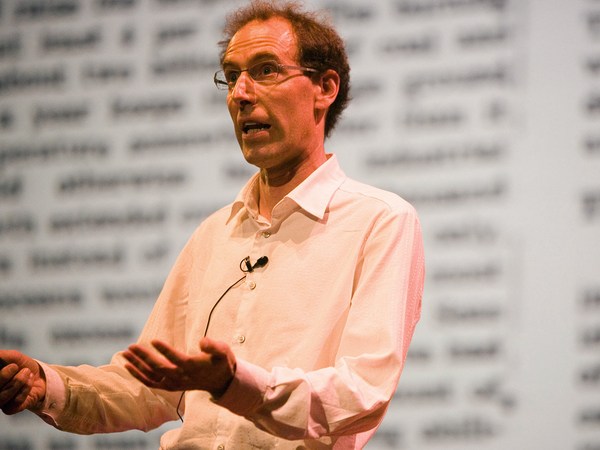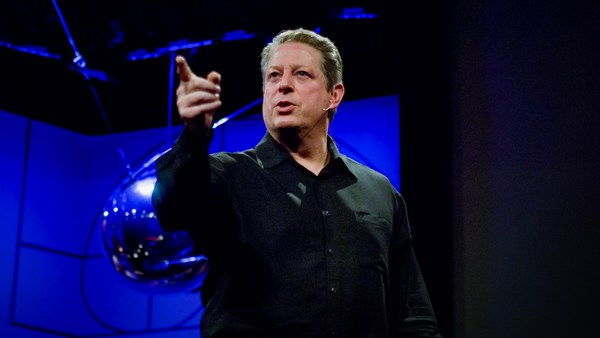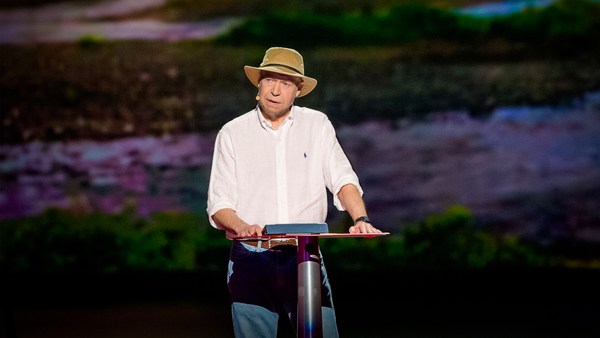Anjali Grover: What we've seen over the last few years is unprecedented levels of investment and innovation. But in order for us to solve the problem in time, we need to put pressure on our leaders to take action now.
[An action plan for solving the climate crisis]
[An updated action plan for solving the climate crisis]
David Biello: You guys have a plan to solve climate change. Tell me about that.
Ryan Panchadsaram: We do. Back in 2020, we set out to apply OKRs to the climate crisis. And OKRs are objectives and key results. It's a goal-setting tool used by thousands of organizations to reach for their most audacious goals. And so in 2021, we published a book and an action plan. And that action plan described how to tackle the climate crisis. But it used these OKRs. So 10 objectives of what we need to accomplish, each paired with a handful of KRs to tell us how we get there, what we need to really do. And then in 2022, we updated speedandscale.com to track how we were doing. And now, for the first time, 2024, we're setting out to answer the hard question of how are we doing in tackling the climate crisis.
DB: So in 2021, you joined us in Edinburgh and gave a talk on stage with John Doerr.
(Video) John Doerr: There are six big objectives. We're going to electrify transportation, which means stop using diesel and gas for our vehicles. We're going to decarbonize the grid with wind and solar and nuclear. We're going to fix our food systems. And that includes eating less meat and dairy, reducing food waste and improving our soil health. Fourth, we’re going to protect nature: that’s stopping deforestation, protecting our oceans. Fifth, we're going to clean up our materials, how we make things like cement and steel. And then sixth, we're going to have to figure out ways to remove the carbon that remains.
DB: What's the update? How have we done?
AG: In many ways, what we found wouldn't surprise you. When we looked at our key results, many of them were off-course or failing. But there was some good news. And I think there's a lot of reason to pay attention to that good news. The first is around electric vehicles. Sales have absolutely skyrocketed. We've seen exponential growth in that category. The second is around renewables. Costs have come down over the last few decades, and they're at historic lows. We're also seeing record deployment. And the third is around venture funding for clean tech. So in 2019, it was at about 16 billion dollars per year. That number soared to about 56 billion dollars in 2021. And it stayed put. What all of that points to is what I think the most under-told story in climate. And that is around temperature projections. So if you go back about 10 years ago, what you would find is when looking at temperature projections for the year 2100, we were looking at about 3.9 degrees Celsius. What that number is today is 2.7 degrees. That means we've made 1.2 degrees of progress. We've shaved off that doomsday scenario. It's still not great. We don't want to live in a 2.7-degree world, but we have made progress.
And I think that's really important to note because, you know, if you look at the headlines and kind of absorb what the news and chatter is around you, we've sort of moved from climate denialism to climate doomerism, and it's made strange bedfellows out of both climate activists and fossil fuel interests. But I think what the story around temperature projections tells us is that we're not making as much progress as we want to be making, but we have made progress and we can continue to make more.
DB: So we've gone from catastrophe to bad ...
AG: And we can do better.
DB: So how can we do better?
RP: The neat thing about the tracker, when you look at what red and orange mean, it means that we are either not moving on those metrics or they're sliding backwards. So when you think about, whether you're an activist, a nonprofit, you're thinking about investing in new companies, these are the areas to spend a lot of attention on. So it's things like how do you tackle beef, methane leaks, deforestation, coal still being burned. So if you're thinking about entering this climate crisis fight, that's where to spend your time and effort. And then there's the handful of areas which are yellow which mean progress is being made, but it's insufficient to get to that 2030 or 2050 target. And then, of course, there are the areas which are green, which means that we're at pace and we're going to get there. A place like electric vehicle sales is one of those. And then there's the few places where you have blue, which means achieved.
AG: What we found over the last few years is that despite the dizzying pace of innovation deployment, despite record levels of investment, we're not on a net-zero pathway. And what that means is that when we look at the problem of climate, we know it's time-bound. We might get there eventually with innovation and investment, but we don't have eventually, as we all know. So what we need is a kind of third leg of the stool. We need innovation and investment, but we also need policy. We have to have the three working together in order to get to a place where we can reduce emissions in half by the end of the decade, and get all the way to net zero by 2050.
DB: OK, so where are the big problem spots? Where do we need to focus our efforts?
RP: Unsurprisingly, the hard-to-abate sectors are where we're struggling the most. So think concrete, think steel. And so when you look at concrete, well to form and create it, you actually have to emit a lot. Like the actual process itself does. And so you need new chemistries and ways to produce concrete and cement. But to fund it, the amount of venture capital going to those areas, it's not where they need to be.
(Video) Tom Schuler: Cement is the glue that holds concrete together. For every ton of cement that's manufactured, almost a ton of CO2 is emitted into the atmosphere. Now, convincing a 2,000-year-old industry, that hasn't evolved much over the last 200 years, is not easy, but there are lots of new and existing industry players that are attacking that challenge.
RP: For green steel, the actual solutions are closer, but you actually need more capital to start deploying those factories and facilities that can use and create green steel, either using electricity or hydrogen. We need not only more capital to deploy the clean alternatives, we need more investment going into the new kinds of chemistries and technologies to have those solutions exist in the next decade and so forth. We have all the solutions today to cut half of our emissions, and we need new ones to get all the way to net zero.
AG: The other area that we need to see much greater improvement on is food. And food is such a diffuse problem. We have problems just about everywhere we look. But in particular, the methane part of the food issue is not a problem that's going to go away any time soon.
(Video) Ermias Kebreab: The process by which grass and fiber is broken up in the stomachs of cows and other grazing ruminants, has a byproduct: methane. A potent greenhouse gas. We have a methane problem from cows.
AG: If you rewind, about three years ago, we were at the advent of the fake meat era. And what we like to say now -- well, we don't really like to say it, but it's that fake meat 1.0 failed and 2.0 can't come soon enough. What we've seen is that that first era of innovation with plant-based proteins really didn't have the stickiness that we wanted it to. It failed to capture the market. But we also have to remember that it's like any other technological innovation. It's at a very nascent stage, and it needs time to develop so that it can improve on taste, on health and on price. The problem right now on food, and in particular with regard to plant-based proteins, is that we're not seeing the investment that we would need in order to make those improvements. In fact, over the last three years, funding has essentially halved year over year. So we've got a kind of insatiable appetite for meat, particularly beef, that we were seeing that demand from all over the world. And we don't have great solutions on the horizon. So fake meat 1.0 failed, 2.0 can't come soon enough, and we really need to pour more dollars into this area to better the product and get it to the next stage.
DB: Although we could also just eat less beef.
AG: Absolutely, and we should.
RP: That recommendation there is so simple yet it orients towards the gigatons. Like, one thing about the Speed and Scale plan is that how do you take all the time that we have to tackle this problem point it towards where you can get the most leverage? And so you're absolutely right, in food, it’s going after beef; we eat less beef, that is one of the primary sources of emissions in the food sector. So is waste and so is improving soils. And so yes, it is that simple. We don't have to be vegan. Eat a lot less beef.
DB: So what can we learn from the success stories? You mentioned EVs.
AG: The best news in climate, David, is cars. We've seen astronomical progress there. We've gone from three percent of new vehicle sales being electric to 17 percent. That's exponential progress. And one of the things that we like to say is if Tesla is the spark that lit the EV revolution, China has been the TNT. It has about 60 percent market share in EVs today. China's leadership on this front is really something that other countries should take note of. We need other countries to step up. This can't be a one-country game, both for economic competitiveness reasons but also for the sake of the planet.
DB: The batteries that kind of fuel the EV industry can be used for many other purposes. They get cheaper as a result of the EVs, and then they're cheaper to put in your house for storage, for the other success story.
AG: Absolutely.
RP: Well, the nice thing about that too is like in the recycling of them too, you also then think about the concerns around mining. Yes, right now there's going to be a level of extraction that has to happen to create these batteries. But if we can do that more responsibly, if that can be spread more equitably around the world, but then think about what happens when you can start to recycle those batteries. But you're right. The other great news area is the pace of clean energy deployment, right? Right now solar and wind are at the cheapest they've ever been. They are cost-competitive to coal and gas. We need storage to get there as well too, but to your point, battery costs are dropping. So that's an achievable piece too. When you talk about the numbers, the pace of solar deployment between this year and last, we're talking about a 50 percent improvement at I think it's 500 gigawatts of clean energy. And that's going to go up next year and continue to go up, like, that is astronomical. And so I think part of the message you want to carry is not only keep the hope that this is possible, but we actually still do need to work a lot harder to tackle this crisis.
DB: So do you both have hope?
RP: The hope comes from seeing the incredible stories of innovators and policymakers and investors that are doing more. And then for me, where I come from, the venture capital sector, that 50 billion going out a year in climate tech companies means that there's I think, like 2,600 companies out there, David, that are trying to build new solutions to tackle this crisis, and that's inspiring.
AG: You know, the climate story isn't yet written. And I think sometimes we tend to talk about it like it is, like we know what's going to happen. I think a lot of the record achievement and progress that we've seen unfold over the last few years shows us that we are making continuous progress. We need more speed and we need more scale. But we can do this. And I think to date, over the last few years, we've really focused on one side of the equation, which is scaling up renewables, and we've made a lot of progress there. Now it's time for us to really put our nose to the ground and focus on how we phase out fossil fuels, because we will not get to net zero unless we tackle that piece of it. It is not enough to do one side of this equation.
RP: We need to have that 1.5-degree intensity. But if we miss it by just a 10th of a degree, we're successful. So I think the debate of is one and a half degrees possible or not, the truth is that window is closing. But if we really care about this problem, we're going to still have that same intensity.
